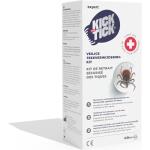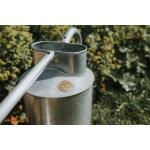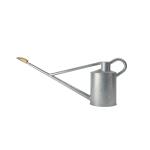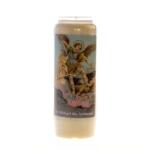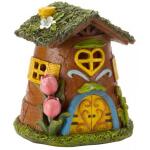 Nieuw
Nieuw 0
0De Kadota vijg
▼ Ga naar meest recente reactie
Mijn Kadota vijg is een jonge plant, staat nog IN POT en geeft voor de eerst maal vruchten.
Vandaag heb ik drie vruchten mogen plukken.
De vruchten krijgen bij rijpheid een geelgroene kleur, een blinkende huid en voelen zacht aan.
De grootte van de vrucht is vier cm ( zonder steeltje) een kleine vrucht dus, opengesneden een roos bruine kleur.
De vijgensoort is nieuw bij mij.
Zijn er mensen die deze vijg in de tuin hebben en die deze periode vruchten kunnen plukken? En iets kunnen vertellen over de winterhardheid van de plant?
Groeten Jende
Vandaag heb ik drie vruchten mogen plukken.
De vruchten krijgen bij rijpheid een geelgroene kleur, een blinkende huid en voelen zacht aan.
De grootte van de vrucht is vier cm ( zonder steeltje) een kleine vrucht dus, opengesneden een roos bruine kleur.
De vijgensoort is nieuw bij mij.
Zijn er mensen die deze vijg in de tuin hebben en die deze periode vruchten kunnen plukken? En iets kunnen vertellen over de winterhardheid van de plant?
Groeten Jende
donderdag 22 oktober 2009 - 14:59
Hallo Jende,
hieronder wat er op internet zoalover jouw vijg te vinden is (met de bronvermelding ernaast)
Kadota (Ray Givan)
A greenish-white fig, small to medium sized. Pyriform. Leaf: base cordate;3-5 lobes; shallow sinuses. Vigorous and precocious. Delicious fresh or dried. It is a rich, sweet, all purpose fig and the most common canned fig. Well-adapted in the Southwest and drier areas of the South. Requires heat to develop its best flavor and texture. Fairly hardy. Synonyms: Dattero, Dottato, White Kadota, ad nauseum.
Kadota (www.crfg.org) syn.: (Dottato, Florentine, White Kadota)
Medium, skin is yellowish green, flesh amber, tinged pink at center. Flavor rich. Resists souring. Little or no breba crop. Tree upright, requires annual pruning to slow growth. Requires hot, dry climate for best quality.
Kadota (Peter Bauwens) (dattero, dottato, white kadota) Groenwitte vijg, amberkleurig van binnen, klein en peervormig. Krachtige groeier en vroeg productief. Geschikt voor vers gebruik en om te drogen. Redelijk winterhard, maar heeft volop warmte te nodig om te rijpen. Geschikt voor teelt onder glas.
KADOTA SYN: WHITE KADOTA, DOTTATO, FLORENTINE, HONEY, GENTILE, DATTERO. WHITE ENDICH
DESCRIPTION Greenish-white fig, small to medium sized. Pyriform. Vigorous. Delicious fresh or dried. It is a rich, sweet, all purpose fig and the most common canned fig. Well-adapted in the Southwest and drier areas of the South. Fairly hardy. (001a) (004) (006) (011) (014) Vigorous tree Fruit medium-sized. Skin tough, yellowish-green. Flesh amber-colored. Nearly seedless. Forms 'honey drop' at eye. Needs warm weather. Flavor rich and sweet. Used for canning commercially, drying or eating fresh. (002) Yellow, very sweet, does well in VA. Very good in hotter areas. Has a few very large early figs followed by a main crop. The sweetest yellow fig. Good for drying. Zones 7- 9. (003) Leaf: base cordate;3-5 lobes; shallow sinuses. Vigorous and precocious. Delicious fresh or dried. It is a rich, sweet, all purpose fig and the most common canned fig. Requires heat to develop its best flavor and texture. Fairly hardy. (006) Medium fruit. Yellowish green to clear yellow skin. Amber flesh with few seeds. When pruned moderately will produce both first and second crops. Tend to over-bear and produce under-sized fruit unless moderately pruned. Good fresh, dried, canned or pickled. Needs hot weather to ripen. Inland valleys. (007) This variety is the commercial fig of California. Varietal trials show it also does well in Texas, particularly in south Texas. The fruit becomes rubbery in drier and hotter areas. The eye is open but it is characteristically filled with a honey-like substance which prevents entry of insects and subsequent souring. Fruiting characteristics are similar to those of Magnolia and Everbearing. It will produce on suckerwood the year after cold injury. The fruit is yellow to green with seeds and amber pulp. The fruit is excellent canned or preserved. Do not plant this variety in drier areas of Texas. (009) [T]he American version of the original Italian Dattato, is thick-skinned and possesses a beautiful creamy amber color when ripe. Practically seedless, this fig is a favorite for canning and preserving as well as drying. (014) Large, light greenish-yellow 'white' skin, amber flesh. Long-lived, vigorous. Prune to any shape. Very sweet fruit needs hot weather to ripen. Fresh/dry/can. 100 hours. Self-fruitful. (025) Medium, skin is yellowish green, flesh amber, tinged pink at center. Flavor rich. Resists souring. Little or no breba crop. Tree upright, requires annual pruning to slow growth. Requires hot, dry climate for best quality. (023) (075)Skin and flesh colors: Yellow-green; amber Best in hot, dry regions, such as California's Central Valley. A leading commercial fig in California. Average-sized, tough-skinned, nearly seedless, figs are used for canning, for drying, or eaten fresh. Vigorous, almost rampant tree is very productive in both spring and fall. (022) Medium, skin is yellowish green, flesh amber, tinged pink at center. Flavor rich. Resists souring. Tree upright, requires annual pruning to slow growth. Requires hot, dry climate for best quality, but is sometimes grown in the cool coastal regions of B.C. (026) (026a) Large, with light greenish-yellow 'white' skin, amber flesh. Very sweet fruit needs hot weather to ripen. Long-lived, vigorous tree can be pruned to any shape. Fresh/dry/can. (034) Needs a lot of heat. (036) Large light greenish yellow skin, amber flesh. Long lived vigorous. Very sweet needs heat to ripen. (057)Fig Varieties for South Carolina: Kadota Bright greenish-yellow Medium to large Fair Excellent (061)Yellow, very sweet, does well in VA. Very good in hotter areas. Has a few very large early figs followed by a main crop. The sweetest yellow fig. Good for drying. (071)A very high quality fig. (001c)I live in East Texas and have had great luck with Texas Everbearing, Brown Turkey, Alma, Kadota and Black Mission as well as my favorite the LSU Purple. (931)The leading commercial canning variety. Medium sized fruit with thin, tough, light greenish-yellow skin. White to amber is tinged with pink. A rich, sweet, flavorful all-purpose fig, great for canning, fresh eating or preserving. Longlived vigorous tree bears June through frost. Very productive. Self-fertile, hardy to 10 degrees F. (076)
SKIN COLOR: YELLOW / GREEN
FLESH COLOR: AMBER
hieronder wat er op internet zoalover jouw vijg te vinden is (met de bronvermelding ernaast)
Kadota (Ray Givan)
A greenish-white fig, small to medium sized. Pyriform. Leaf: base cordate;3-5 lobes; shallow sinuses. Vigorous and precocious. Delicious fresh or dried. It is a rich, sweet, all purpose fig and the most common canned fig. Well-adapted in the Southwest and drier areas of the South. Requires heat to develop its best flavor and texture. Fairly hardy. Synonyms: Dattero, Dottato, White Kadota, ad nauseum.
Kadota (www.crfg.org) syn.: (Dottato, Florentine, White Kadota)
Medium, skin is yellowish green, flesh amber, tinged pink at center. Flavor rich. Resists souring. Little or no breba crop. Tree upright, requires annual pruning to slow growth. Requires hot, dry climate for best quality.
Kadota (Peter Bauwens) (dattero, dottato, white kadota) Groenwitte vijg, amberkleurig van binnen, klein en peervormig. Krachtige groeier en vroeg productief. Geschikt voor vers gebruik en om te drogen. Redelijk winterhard, maar heeft volop warmte te nodig om te rijpen. Geschikt voor teelt onder glas.
KADOTA SYN: WHITE KADOTA, DOTTATO, FLORENTINE, HONEY, GENTILE, DATTERO. WHITE ENDICH
DESCRIPTION Greenish-white fig, small to medium sized. Pyriform. Vigorous. Delicious fresh or dried. It is a rich, sweet, all purpose fig and the most common canned fig. Well-adapted in the Southwest and drier areas of the South. Fairly hardy. (001a) (004) (006) (011) (014) Vigorous tree Fruit medium-sized. Skin tough, yellowish-green. Flesh amber-colored. Nearly seedless. Forms 'honey drop' at eye. Needs warm weather. Flavor rich and sweet. Used for canning commercially, drying or eating fresh. (002) Yellow, very sweet, does well in VA. Very good in hotter areas. Has a few very large early figs followed by a main crop. The sweetest yellow fig. Good for drying. Zones 7- 9. (003) Leaf: base cordate;3-5 lobes; shallow sinuses. Vigorous and precocious. Delicious fresh or dried. It is a rich, sweet, all purpose fig and the most common canned fig. Requires heat to develop its best flavor and texture. Fairly hardy. (006) Medium fruit. Yellowish green to clear yellow skin. Amber flesh with few seeds. When pruned moderately will produce both first and second crops. Tend to over-bear and produce under-sized fruit unless moderately pruned. Good fresh, dried, canned or pickled. Needs hot weather to ripen. Inland valleys. (007) This variety is the commercial fig of California. Varietal trials show it also does well in Texas, particularly in south Texas. The fruit becomes rubbery in drier and hotter areas. The eye is open but it is characteristically filled with a honey-like substance which prevents entry of insects and subsequent souring. Fruiting characteristics are similar to those of Magnolia and Everbearing. It will produce on suckerwood the year after cold injury. The fruit is yellow to green with seeds and amber pulp. The fruit is excellent canned or preserved. Do not plant this variety in drier areas of Texas. (009) [T]he American version of the original Italian Dattato, is thick-skinned and possesses a beautiful creamy amber color when ripe. Practically seedless, this fig is a favorite for canning and preserving as well as drying. (014) Large, light greenish-yellow 'white' skin, amber flesh. Long-lived, vigorous. Prune to any shape. Very sweet fruit needs hot weather to ripen. Fresh/dry/can. 100 hours. Self-fruitful. (025) Medium, skin is yellowish green, flesh amber, tinged pink at center. Flavor rich. Resists souring. Little or no breba crop. Tree upright, requires annual pruning to slow growth. Requires hot, dry climate for best quality. (023) (075)Skin and flesh colors: Yellow-green; amber Best in hot, dry regions, such as California's Central Valley. A leading commercial fig in California. Average-sized, tough-skinned, nearly seedless, figs are used for canning, for drying, or eaten fresh. Vigorous, almost rampant tree is very productive in both spring and fall. (022) Medium, skin is yellowish green, flesh amber, tinged pink at center. Flavor rich. Resists souring. Tree upright, requires annual pruning to slow growth. Requires hot, dry climate for best quality, but is sometimes grown in the cool coastal regions of B.C. (026) (026a) Large, with light greenish-yellow 'white' skin, amber flesh. Very sweet fruit needs hot weather to ripen. Long-lived, vigorous tree can be pruned to any shape. Fresh/dry/can. (034) Needs a lot of heat. (036) Large light greenish yellow skin, amber flesh. Long lived vigorous. Very sweet needs heat to ripen. (057)Fig Varieties for South Carolina: Kadota Bright greenish-yellow Medium to large Fair Excellent (061)Yellow, very sweet, does well in VA. Very good in hotter areas. Has a few very large early figs followed by a main crop. The sweetest yellow fig. Good for drying. (071)A very high quality fig. (001c)I live in East Texas and have had great luck with Texas Everbearing, Brown Turkey, Alma, Kadota and Black Mission as well as my favorite the LSU Purple. (931)The leading commercial canning variety. Medium sized fruit with thin, tough, light greenish-yellow skin. White to amber is tinged with pink. A rich, sweet, flavorful all-purpose fig, great for canning, fresh eating or preserving. Longlived vigorous tree bears June through frost. Very productive. Self-fertile, hardy to 10 degrees F. (076)
SKIN COLOR: YELLOW / GREEN
FLESH COLOR: AMBER
dinsdag 27 oktober 2009 - 21:26
Figo,
Dank je voor de interessante uitleg,
Ik heb een bezoek gebracht aan het tuincentrum Floralux te Dadizele (in West-Vlaanderen), en daar hebben ze vele vijgensoorten.
Daar heb ik de vijg DOTTATO op stam gezien, en er is NIEMAND die daar wel een woord uitleg kan geven over de aangeboden vijgensoorten.
Ik zoek namelijk vijgensoorten waarvan ik kan plukken vanaf Juli tot Oktober.
Ik heb Browm Turkey in de tuin en die geeft vijgen vanaf de tweede week van Juli tot met de tweede week van Augustus.
Ik zoek nog een vijgensoort die vijgen geeft vanaf de tweede week van Augustus tot half September, en als er dan nog een vijgensoort is die daarop aansluit is die welkom, maar ik ken de namen van die soorten niet.
Ken jij soms enkele namen?
Groeten Jende
Dank je voor de interessante uitleg,
Ik heb een bezoek gebracht aan het tuincentrum Floralux te Dadizele (in West-Vlaanderen), en daar hebben ze vele vijgensoorten.
Daar heb ik de vijg DOTTATO op stam gezien, en er is NIEMAND die daar wel een woord uitleg kan geven over de aangeboden vijgensoorten.
Ik zoek namelijk vijgensoorten waarvan ik kan plukken vanaf Juli tot Oktober.
Ik heb Browm Turkey in de tuin en die geeft vijgen vanaf de tweede week van Juli tot met de tweede week van Augustus.
Ik zoek nog een vijgensoort die vijgen geeft vanaf de tweede week van Augustus tot half September, en als er dan nog een vijgensoort is die daarop aansluit is die welkom, maar ik ken de namen van die soorten niet.
Ken jij soms enkele namen?
Groeten Jende
dinsdag 27 oktober 2009 - 22:09
Figo,
Sorry voor de enklele tikfouten, zoals (sterven) , het moet zijn d i e , ik denk dat de computer vertaald.
grt. Jende
Sorry voor de enklele tikfouten, zoals (sterven) , het moet zijn d i e , ik denk dat de computer vertaald.
grt. Jende
dinsdag 27 oktober 2009 - 22:20
Als je wil een lange periode plukken zal je moeten soorten zoeken met verschillend "rijpingstijdstip". Eventueel soorten die in de winter (in pot of kuip) in de serre kunnen overwinteren, om dan in mei/juni de eerste vruchten te geven. Een soort als Galbun of Everbearing is daar goed voor.
En dan opeenvolgende soorten buiten. Brunswick, bijvoorbeeld. Everbearing en Galbun geven een 2de oogst buiten (dezelfde planten die in de serre hebben gestaan)
Momenteel heb ik nu nog een paar vruchten van de Précoce de Bordeaux.
Dottato is ook goed middentijds buiten, net als de Dalmatie
En dan opeenvolgende soorten buiten. Brunswick, bijvoorbeeld. Everbearing en Galbun geven een 2de oogst buiten (dezelfde planten die in de serre hebben gestaan)
Momenteel heb ik nu nog een paar vruchten van de Précoce de Bordeaux.
Dottato is ook goed middentijds buiten, net als de Dalmatie
dinsdag 27 oktober 2009 - 22:36
Portogallo geeft zeer grote vijgen en is zeer vruchtbaar, en is veel beter van smaak dan brown Turkey. Ik heb nog verschillende soorten, een 2O tal waarvan er 4 al 30 jaar in volle grond staan maar ben niet zeker van de namen, ik denk ronde de bordeaux, dalmate, ceretto, …… ? De kadota draagt zeer snel en geeft mooie gele vruchten, ze staan in pot in de serre om verder af te rijpen.
woensdag 16 oktober 2019 - 16:39
Voeg een reactie toe
Log in of registreer om dit onderdeel te gebruiken
 Laatste artikels
Laatste artikels Tuinieren
Tuinieren Planten
Planten Dieren
Dieren Vijver & zwembad
Vijver & zwembad De moestuin
De moestuin Bloemschikken
Bloemschikken De tuinkas
De tuinkas Klimaatopwarming
Klimaatopwarming Tuinproblemen
Tuinproblemen Tuinbabbel
Tuinbabbel Forum
Forum




 Promo's
Promo's Herfsttips
Herfsttips Zaden en bloembollen
Zaden en bloembollen Planten opkweken
Planten opkweken Aanleg en inrichting
Aanleg en inrichting Tuinapotheek
Tuinapotheek Decoratie en sfeer
Decoratie en sfeer In en om het huis
In en om het huis Kas en tuinhuis
Kas en tuinhuis Laatste artikels
Laatste artikels Tuinieren
Tuinieren Planten
Planten Dieren
Dieren Vijver & zwembad
Vijver & zwembad De moestuin
De moestuin Bloemschikken
Bloemschikken De tuinkas
De tuinkas Klimaatopwarming
Klimaatopwarming Tuinproblemen
Tuinproblemen

